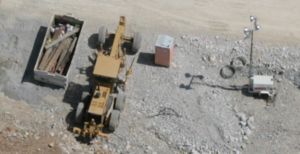Category:618 Mobilization
Mobilization includes the movement and preparation of facilities, equipment, supplies and personnel for work on the project. Mobilization costs are included on every project and may be estimated at
- 4% to 5% for pavement surfacing (resurfacing, seal coat, UBAWS, etc.),
- 5% to 6% for grading and turn-key projects,
- 7% to 8% for bridge projects and
- up to 10% for miscellaneous projects.
The percent selected should be applied to the project’s total cost (the cost that includes all items) when the estimate has been completed. This figure will be more carefully analyzed and adjusted by Design.
No standard plan is associated with mobilization, but the Mobilization standard spec is included in the Missouri Standard Specification for Highway Construction.
See EPG 103.2 Contract Bond for Sec 103.4 for guidance on how to adjust mobilization in order to reimburse the contractor for the cost of the contract bond and railroad liability insurance.
Basis of Payment for Mobilization (Per Sec 618.2 Basis of Payment)
Sec 618 describes how the RE should calculate progress payments for mobilization and when to make each payment. This specification is set up to pay the contractor incrementally for mobilization and also discourage excessive mobilization bids. Before calculating the amount of the mobilization payments, the RE should first verify whether the contractor wishes to exercise the option to receive immediate payment for the contract bond and/or railroad liability insurance. This adjustment to mobilization should be made as stated in EPG 103.2 Contract Bond for Sec 103.4.
The incremental mobilization payments will be the lesser of these two amounts.
- Amount 1: Adjust the mobilization down for contract bond and/or railroad liability insurance (when appropriate) then divide that adjusted price by four to determine the amount of the four equal payments.
- Amount 2: Multiply 2.5% times the original contract amount.
If Amount 2 is the lower amount any remaining mobilization after the four payments are made will not be paid until the final inspection (i.e. all corrections are complete and the project has been accepted for maintenance).
Examples are provided below for both scenarios. Refer to Sec 618 for direction on when to make each of the four partial payments.
Example 1
The contract amount is $1,400,000. Mobilization was bid at $100,000. The contract bond was $10,000 and the railroad insurance bond was $10,000.
The contract bond and railroad insurance is submitted and paid at the beginning of the project. These amounts are deducted from mobilization. Therefore, the original mobilization bid of $100,000 minus $20,000 ($10,000 for the railroad plus $10,000 for the contract bond) leaves a remainder of $80,000 for mobilization.
Partial payments are the lesser of 2.5 percent times the original contract price of $1,400,000, which is $35,000, or 25 percent of the remaining mobilization of $80,000, which is $20,000. The smaller amount is $20,000 which will be used as the payment at the incremental completion percentages.
- 1. When 5 percent of the original contract is completed ($1,400,000 times 5 percent = $70,000) a mobilization payment of $20,000 would be paid.
- 2. When 10 percent of the original contract is completed ($1,400,000 times 10 percent = $140,000) an additional mobilization payment of $20,000 would be paid.
- 3. When 25 percent of the original contract is completed ($1,400,000 times 25 percent = $350,000) an additional mobilization payment of $20,000 would be paid.
- 4. When 50 percent of the original contract is completed ($1,400,000 times 50 percent = $700,000) the final mobilization payment of $20,000 would be paid.
Example 2
The contract amount is $2,000,000. Mobilization was bid at $500,000. The contract bond was $70,000 and the railroad insurance bond was $30,000.
The contract bond and railroad insurance is submitted and paid at the beginning of the project. These amounts are deducted from mobilization. Therefore, the original mobilization bid of $500,000 minus $100,000 ($30,000 for the railroad plus $70,000 for the contract bond) leaves an adjusted value of $400,000 for mobilization.
Partial payments are the lesser of 2.5 percent times the original contract price of $2,000,000, which is $50,000, or 25 percent of the adjusted mobilization of $400,000, which is $100,000. The lesser amount of $50,000 will be used as the payment at the incremental completion percentages.
- 1. When 5 percent of the original contract is completed ($2,000,000 times 5 percent = $100,000) a mobilization payment of $50,000 would be paid.
- 2. When 10 percent of the original contract is completed ($2,000,000 times 10 percent = $200,000) an additional mobilization payment of $50,000 would be paid.
- 3. When 25 percent of the original contract is completed ($2,000,000 times 25 percent = $500,000) an additional mobilization payment of $50,000 would be paid.
- 4. When 50 percent of the original contract is completed ($2,000,000 times 50 percent = $1,000,000) an additional mobilization payment of $50,000 would be paid.
- 5. When the engineer has accepted the project for maintenance in accordance with Sec 105 the remaining mobilization amount of $200,000 would be paid.
Additional Mobilization for Seeding
Additional Mobilization for Seeding provides compensation for additional mobilization to perform temporary or permanent seeding beyond the initial occurrence, per Sec 806.50.2, and as required per terms of the SWPPP. Additional mobilization should be provided on projects where construction activities disturb an acre or more over the life of a project (see Sec 618.3).
